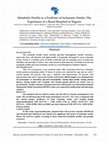Papers by Orebowale Olugbemide

Journal of Advances in Medicine and Medical Research
Aim: This study aimed to assess the knowledge of coronavirus disease 2019 (COVID-19) and the perc... more Aim: This study aimed to assess the knowledge of coronavirus disease 2019 (COVID-19) and the perception of care among diabetes mellitus patients during the COVID-19 pandemic. Methods: This was a cross-sectional study among 173 diabetes mellitus patients over 12 weeks in the endocrinology outpatient clinic. An interviewer-administered questionnaire was used to acquire data on socio-demographic and clinical characteristics, as well as questions to assess COVID-19 knowledge and perception of care. The data acquired were analyzed using SPSS, and a p-value less than 0.05 was considered significant. Results: A total of 173 diabetes mellitus patients participated in the study, and there were more females than males (59% vs. 41%). The participants' mean age was 55.8 ± 14.9 years. The mean knowledge score was 12.42 ± 6.01, and the majority (51.4%) of the participants had poor knowledge of COVID-19 while 11.0% had good knowledge of COVID-19. Higher levels of education and monthly income w...

African Journal of Health Sciences, Jan 19, 2023
The metabolic profile which includes glycated haemoglobin, insulin resistance, pancreatic beta ce... more The metabolic profile which includes glycated haemoglobin, insulin resistance, pancreatic beta cell function and lipid profile is frequently deranged in acute ischaemic stroke. Stroke is a leading cause of death worldwide and an emerging cause of long-term disability and mortality in Africa. Our study aimed to determine the correlation between the metabolic profile and acute ischaemic stroke in a rural Hospital in Southern Nigeria. This was a prospective cross-sectional study. Fifty consecutive first-ever ischaemic stroke patients presenting within 72 hours of stroke were matched for age and sex with 3 control groups (49 persons with type 2 diabetes and hypertension, 49 persons with hypertension only and 57 apparently healthy individuals). Blood samples were obtained from all participants to determine glycated haemoglobin, fasting lipid profile, fasting plasma glucose, fasting insulin and C-peptide and random plasma glucose (in stroke cases at presentation). Insulin resistance and pancreatic beta-cell function were determined using the Homeostatic Model Assessment (HOMA). Data were analysed by multivariate and univariate statistics. One hundred and two (49.8%) males and 103 (50.2%) females participated in the study. The overall mean age of the study participants was 61.6 ± 10.1 years. Compared with the control groups, predictors of acute ischaemic stroke were Fasting insulin (hyperinsulinaemia) [OR (95%CI) = 1.108 (1.043-1.178), p= 0.001], HOMA-β% [OR (95%CI) = 0.994 (0.990-1.001) p=0.006] and total cholesterol [OR (95%CI)= 0.009 (0.001-0.012) p=0.022]. In this study, hyperinsulinaemia, impaired beta-cell secretory function (HOMA-β) and elevated total cholesterol were found to be significant risk factors of ischaemic stroke. Hence, the need for regular screening to detect abnormal metabolic profiles and prompt treatment.

Journal of Evolution of Medical and Dental Sciences
BACKGROUND Despite the increasing prevalence of fibromyalgia, there has been little or no attenti... more BACKGROUND Despite the increasing prevalence of fibromyalgia, there has been little or no attention to its diagnosis and treatment in the undergraduate medical curriculum. This study intended to assess the knowledge and awareness of fibromyalgia among undergraduate medical students in Nigeria. METHODS This was a cross-sectional, descriptive survey conducted from September to December 2021. A total of 175 clinical students participated in the survey. The questionnaire comprised sociodemographic data and questions related to fibromyalgia. A scoring system was developed to stratify knowledge of fibromyalgia into very low, low, average, high, and very high. The level of significance was set at P < 0.05. RESULTS Responses were obtained from 175 clinical students with a mean age of 25.14 ± 3.21 years. Most of the participants (38.3 %) had low fibromyalgia knowledge levels. The main sources of information on fibromyalgia were clinical postings (47.1 %) and the internet (37.1 %). Widespr...
Endocrine Abstracts, 2015

International Journal of TROPICAL DISEASE & Health
Objective: This study aimed to determine the prevalence, distribution, and treatment outcomes of ... more Objective: This study aimed to determine the prevalence, distribution, and treatment outcomes of tuberculosis (TB) in a rural hospital in Nigeria. Methods: This was a retrospective cross-sectional study conducted between 2013 and 2022. The data on all patients diagnosed with TB during the study period were collected from the hospital's registry. The data was then entered into SPSS for analysis. The level of statistical significance was set at P < 0.05. Results: The overall prevalence of TB among TB suspects was 41.3%. Pulmonary TB was the most common form of TB, accounting for 87.1% of the cases, while extrapulmonary TB accounted for 12.9%. Among extrapulmonary TB cases, TB lymphadenitis was the most common (27.2%). The mean age of the patients was 44.7±10.9 years, with the majority of cases in the 51-60 and 31-40-year age groups. Males were more affected than females (59.1% vs. 40.9%), and 5.6% of TB patients were HIV-positive. The frequency of rifampicin-resistant TB was 9....

International Journal of Tropical Disease and Health, 2024
Background: Malaria is a public health concern deeply ingrained within local communities in sub-S... more Background: Malaria is a public health concern deeply ingrained within local communities in sub-Saharan Africa. Local beliefs and practices play a critical role in defining the effectiveness of control measures. This study aimed to assess the knowledge, attitudes, and practices regarding malaria in a rural community in South-South Nigeria. Methods: This cross-sectional study was conducted in Ugun in South-South Nigeria. Data were collected from the participants using an interviewer-administered questionnaire. Data analysis was performed using SPSS and a P-value of < 0.05 was considered significant. Results: This study included 300 participants with a mean age of 51.6 ± 20.9 years. The results showed that 28.3% had good knowledge, 55.7% had a positive attitude, and 44.7% demonstrated good practices regarding malaria. Knowledge scores were associated with the education (P < 0.012) and occupation (P < 0.001) of participants, while attitude scores were associated with the occupation (P = 0.002) and marital status of participants (P < 0.001). Age, education, occupation, and marital status were associated with participants' practice scores (P < 0.001). Civil servants (OR = 4.97; 95% CI: 1.69-14.61; P = 0.004) and pensioners (OR = 7.26; 95% CI: 1.98-26.61; P = 0.003) had higher odds of having good knowledge of malaria than farmers. Married participants (OR = 5.02; 95% CI: 1.51-16.66; P = 0.008) and those with good knowledge (OR = 1.94; 95% CI: 1.11-3.42; P = 0.021) had higher odds of exhibiting a positive attitude. Participants with primary (OR = 6.21; 95% CI: 2.59-14.86; P < 0.001) and secondary (OR = 12.04; 95% CI: 3.89-37.31); P < 0.001) education had higher odds of adopting good practices than those with informal education. Conclusion: Although more than half of the participants had a positive attitude towards malaria, the majority showed insufficient knowledge and poor practices related to the disease. This highlights the pressing need for targeted public health educational programs to improve community understanding and promote effective practices for malaria control.











Uploads
Papers by Orebowale Olugbemide